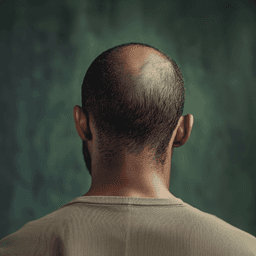Minoxidil and finasteride are the two main medicines for male hair loss in the UK. So, how do they compare, and which one is right for you? Here’s what to know.
Key Takeaways
- Mechanism of action: Finasteride blocks 5-alpha reductase to lower DHT, minoxidil increases blood flow to the hair roots
- Efficacy: Finasteride shows improvement in 80.5% of people, minoxidil for 59%
- UK availability for hair loss: Private prescription
- Side effects: Includes loss of libido and erectile dysfunction (finasteride), skin irritation and palpitations (minoxidil). Side effects are usually reversible.
- Safety profile: Both are well-studied and generally well-tolerated when used as directed.

Finasteride vs minoxidil: what’s the difference?
The main thing that sets finasteride and minoxidil apart is how they work.
Finasteride blocks the action of the enzyme 5-alpha reductase, which in turn lowers levels of a hormone called DHT. What DHT does is make your hair follicles shrink over time, until hair eventually stops growing out of them. So, having less DHT may prevent hair loss.
Whereas minoxidil encourages hair growth by increasing blood flow to your hair roots. This helps new hairs to grow more quickly, and for hairs to grow for longer before they shed.
Here’s an overview of how finasteride and minoxidil compare:
FYI: These two aren’t the only options for male pattern hair loss. (If you’re also comparing branded Propecia with generic finasteride, our Propecia vs finasteride guide explains the difference.)
At MANUAL, we also offer:
- Topical 10% minoxidil spray (used once daily)
- All-in-one topical spray combining finasteride and minoxidil
- All-in-one capsule containing finasteride and minoxidil or dutasteride and minoxidil
Your clinician will help decide which option is safest and most effective for you.
Minoxidil vs finasteride: effectiveness
In scientific research, finasteride tends to come out on top. One study that compared the two drugs head-to-head found that finasteride was more effective at treating mild to severe hair loss than topical minoxidil.
Another review of multiple studies found that people taking finasteride had a greater increase in hair count than those using topical minoxidil after 48 weeks. See our guide on how long finasteride takes to work to understand what this timeline typically looks like.
Can you take finasteride and minoxidil together?
Yes, you can. They are commonly used together because they work in different ways and do not interact. Finasteride lowers scalp DHT, which helps protect follicles from further damage. Minoxidil improves blood flow and extends the hair growth phase, so hairs grow back thicker and for longer.
Minoxidil and finasteride results
In fact, taking both finasteride and minoxidil has been shown to be more effective than using either on their own.
Per a review of five clinical trials, men taking both medicines had visibly more hair compared to those taking either drug alone. And in another study of 450 men, 94.1% of those on the combination therapy showed an improvement versus just finasteride (80.5%) or minoxidil (59%).
Side effects and safety of finasteride and minoxidil
Every medicine can cause side effects, but most men tolerate finasteride and minoxidil well. When side effects do occur, they are usually mild and temporary, and rarely require stopping treatment. If you ever notice a change or feel unsure, speak with your clinician. Sometimes a dose or formulation adjustment can help.
Finasteride
Some finasteride side effects are:
- Reduced libido
- Difficulty getting or maintaining an erection
- Increased breast issue (gynaecomastia)
- Changes in mood, including low mood or anxiety
You should stop taking finasteride—and check in with your doctor—if you get symptoms of an allergic reaction (swelling of the lips, tongue, face or throat) or persistent mood change.
Minoxidil
Common side effects of minoxidil include:
- Headache
- Mild scalp irritation or dryness (with topical use)
- Shortness of breath
- Water retention or swelling in the hands, feet, or ankles
- Changes in heart rate
- Low blood pressure
Sometimes, side effects can be more serious. If you notice any chest pain, swelling in your face (this could be a sign of an allergic reaction), a faster heartbeat, weakness or dizziness, check in with your doctor right away.
Minoxidil isn’t recommended if you have uncontrolled high or low blood pressure or certain heart problems, such as a recent heart attack, stroke or mini-stroke. Your clinician will review your medical history before prescribing.
And by the way: some people experience an increase in hair shedding when they start minoxidil.This is a normal response. Minoxidil can speed up the old shedding phase so follicles can restart a new growth phase. In other words, these are hairs that were going to fall out anyway, they are just shedding sooner, and new hairs follow. This usually settles within 6-12 weeks.
Finasteride and minoxidil UK availability, prescriptions and cost
Looking for finasteride and minoxidil in the UK? Treatments for male pattern hair loss are usually not available on the NHS, as they are considered cosmetic rather than medically necessary.
But you can get both via private prescription, from registered clinics and online pharmacies. With MANUAL, you can get finasteride and minoxidil posted to you from just £18 per month.
To get started, take our hair loss quiz. Our team of clinicians will assess your results and confirm which treatment is best.





